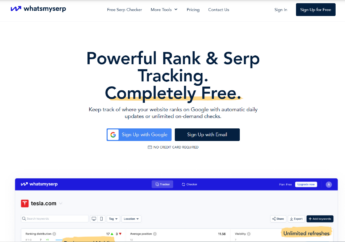How Does A Tracking Link Work?
by Arnab Dey Technology Published on: 22 October 2022 Last Updated on: 27 February 2025

A tracking link is a URL or unique web address that redirects consumers to an advertiser’s website or landing pages. Affiliates get a cut of the sale when a consumer clicks their link to make a purchase.
Link Tracking For Affiliate Marketing
It is essential to have a firm understanding of affiliate marketing before delving into link tracking.
First, an affiliate advertises a link on its website or social media channels. Then, a customer activates the tracking link by clicking on it.
When a customer clicks on your link, it deposits a tracking parameter — a cookie — in the customer’s browser to track conversions made through that particular link for a specified time period. This allows the affiliate to receive a commission on sales made by the consumer up to a few weeks after the first click (depending on the advertiser policy).
Commissions are then paid to the affiliate for each sale.
Affiliate Link Tracking Explained
Affiliate performance can be tracked by using a special URL that includes the affiliate’s ID. Each affiliate link has the affiliate’s unique ID — it typically looks something like “merchantID=123” — inside the link itself, which enables the affiliate’s efforts to be attributed to a specific conversion.
Affiliate links typically include the affiliate’s ID but may provide additional information related to the affiliate network, merchant, affiliate program (if a merchant offers more than one), and destination.
Affiliates and advertisers both benefit greatly from this data since it allows the former to monitor their partners’ performance and the latter to be paid accurately (for this, affiliates can even use an independent tracking system).
Cookie Tracking VS. Cookieless Tracking

Affiliate links may be monitored either with or without the use of cookies.
1. Cookie Tracking
Advertisers can set a cookie’s expiration date and time, allowing them to see how long an affiliate’s ID has been stored in the customer’s browser.
Once the tracking system records and transmits the cookie information, the advertiser then knows which affiliate was responsible for generating a particular lead. This happens, for example, when the lead makes a purchase from the merchant. One drawback of this approach is that link tracking won’t occur if the lead’s cookie times out or if they switch browsers.
2. Cookieless Tracking
All data pertaining to the caller and the affiliate, including the transaction ID, is stored on the advertiser’s server using cookieless tracking, thus eliminating the need for the caller’s device or browser to be actively involved in the tracking process. When a potential customer clicks the link, their details are sent to the affiliate tracking system.
Tracking without cookies is preferred since sales won’t be lost if the visitor changes browsers or the cookie expires.
Setting up an extended cookie expiration period — say 180 days or even many years — may help alleviate the issues associated with using cookies. However, there is still a possibility that the customer may delete their browser’s cache or switch to another browser.
In any case, an automated approach is always preferable. Comprehensive click-tracking platforms — such as Phonexa’s click-tracking software, Lynx — make it so that anybody can set up their own link tracking service within a few minutes by following simple, in-depth, and well-documented instructions. Doing so allows users to instantly reap the benefits from their affiliate marketing efforts.
Affiliate Link Tracking: An Overview

Follow this simple overview to get started with affiliate link tracking.
1. Get Set Up
Use Lynx to set up and monitor your affiliate network’s campaigns.
2. Add Affiliates
Including trackable affiliate links on SEO landing pages designed for each advertisement is a great way to get new partners to join your network.
3. Increase Your Affiliate ROI
Use a robust dashboard to compile all of your affiliate tracking data. From there, make payouts promptly and reward top-performing affiliate marketers.
Affiliate marketing is mutually beneficial for brands and affiliates alike. Brands connect with consumers they wouldn’t be able to reach otherwise, while partners have several ways to increase their earnings.
Travelpayouts, for example, is a travel partnership platform that brings content producers, travelers, and travel companies together by rewarding content creators for promoting the brands they love.
- Cheap, ideal tours are booked by visitors eager to travel the world
- Collaboration between travel firms and influencers/content producers helps spread the word and boost sales
The Most Common Mistake When Tracking Affiliate Links
Using a single link for an entire marketing campaign makes it hard to recognize which marketing channel resulted in the most conversions. This is one of the most significant errors you can make since it will invalidate your tracking efforts.
It’s important to have unique links for each of your advertisements. Each of your promotional efforts — headers, sidebars, blog posts, emails — should have its own unique link so they can be monitored and optimized.
Moving Forward
Tracking affiliate links is crucial for attributing sales to individual affiliates and paying them accordingly. Consider that 83% of marketing professionals believe the most important metric to track is the total number of clicks on affiliate links.
The same is true for affiliate marketing. Without link tracking, it would be impossible to optimize your campaigns and achieve conversion goals. Affiliate link tracking results in a higher return on investment, better recognition of your brand, and less time and money spent on unnecessary activities.
Leverage automated solutions — like Phonexa’s click-tracking software — to get a competitive edge in the ever-evolving affiliate marketing industry.
Read Also:



































































































